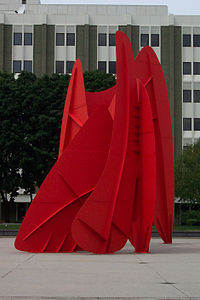La Grande Vitesse
| La Grande Vitesse | |
|---|---|
 |
|
| Artist | Alexander Calder |
| Year | 1969 |
| Type | Painted steel |
| Dimensions | 13 m × 9.1 m × 16 m (43 ft × 30 ft × 54 ft) |
| Location | Civic Center (downtown), Grand Rapids, Michigan |
| Coordinates: 42°58′10″N 85°40′15″W / 42.96937°N 85.67075°W | |
La Grande Vitesse, a public sculpture by American artist Alexander Calder, is located on the large concrete plaza surrounding City Hall and the Kent County Building in Grand Rapids, Michigan, United States.
The sculpture was the first public art work funded by the Art in Public Places program of the National Endowment for the Arts (NEA). Fabricated in Tours, France and assembled on the plaza, the steel sculpture is 43 feet tall, 54 feet long, and 30 feet wide, and weighs 42 tons. It is painted in Calder's signature bright red. The title is French for “the great swiftness”, which can also be translated as "grand rapids".
Calder’s design for La Grande Vitesse was consistent with other monumental sculptures he was commissioned to create during this period in his career. He dubbed these works “stabiles,” a counterpart to his mobiles. Whereas a mobile’s motion is generated by air currents, a stabile activates a viewer’s motion. The sculpture is a popular gathering place for residents and tourists alike, and it is the centerpiece of the city’s annual Festival of the Arts.
A panel of local officials and nationally recognized art experts selected Calder for the commission in 1967. After Calder was chosen and residents learned of his plans, a controversy ensued. Opponents wrote letters to the editor and created songs and cartoons deriding the sculpture, and advocates used the mayor’s bully pulpit and public service television to call attention to Calder’s credentials and vision. La Grande Vitesse was formally dedicated on June 14, 1969, and has since become a popular civic symbol.
After receiving the architectural plans and specified materials for the development of the site, Calder completed an 8-foot maquette in 1968, and began fabrication at the Biémont foundry in Tours, France later that year. The work was shipped in 27 pieces, packed in wooden crates and assembled on-site over five days. According to project advocate Nancy Mulnix Tweddale, "It was all laid out like a jigsaw puzzle. It was fascinating for people to watch this big object grow before their very eyes. The sparks flew as the welders worked and then the vivid color was painted on. It was like outdoor theater."
...
Wikipedia
